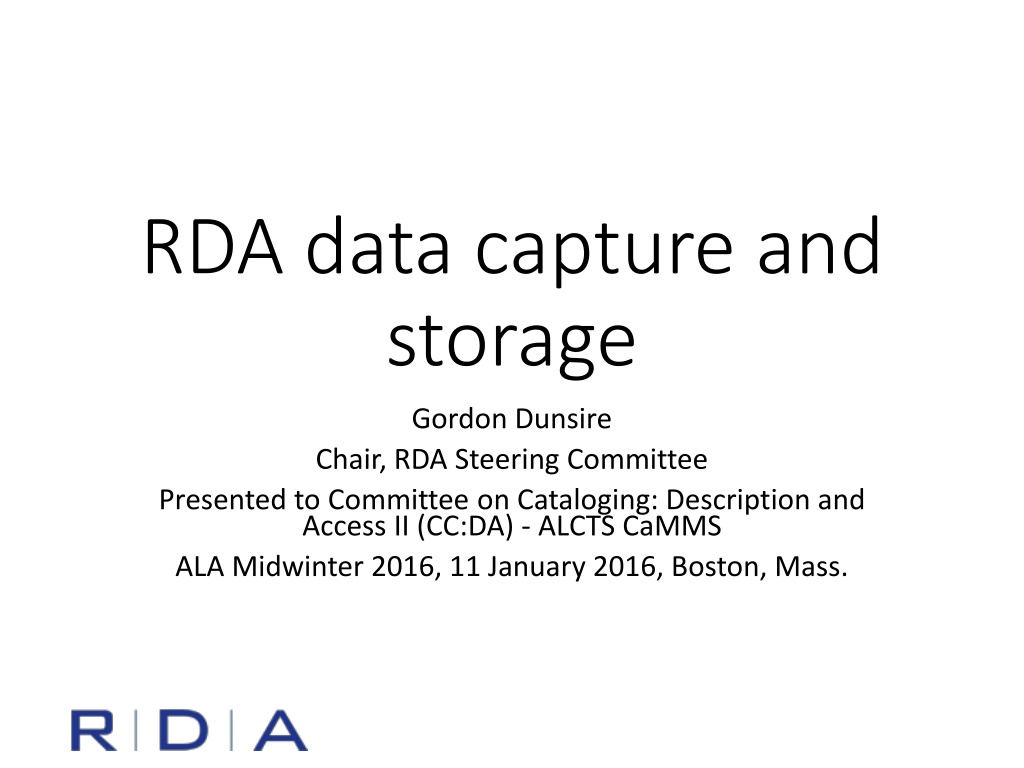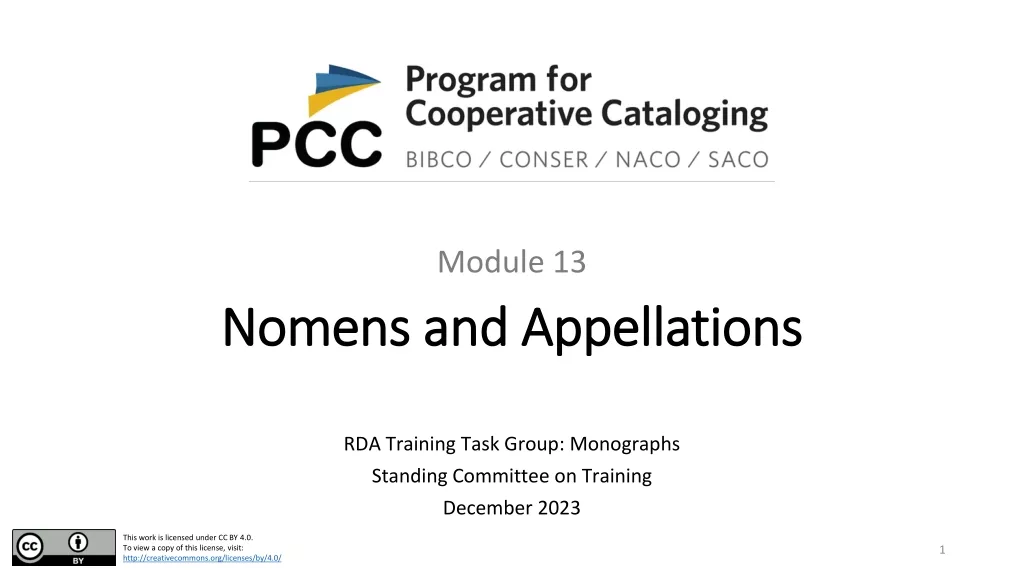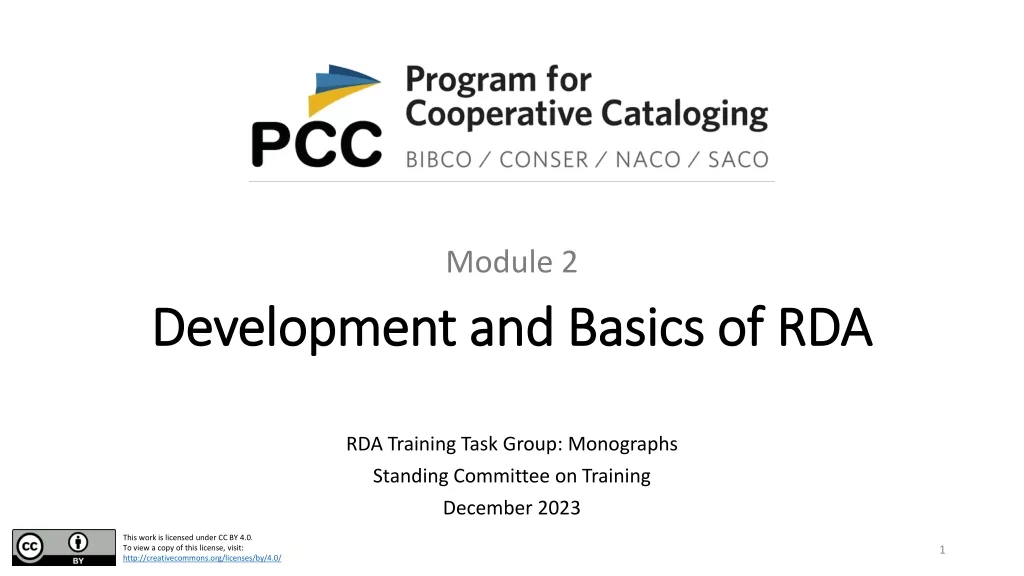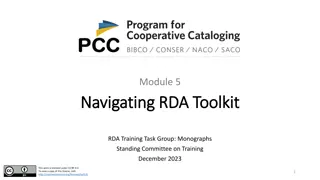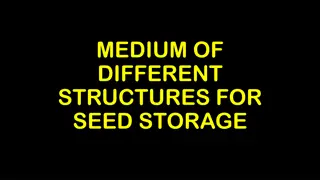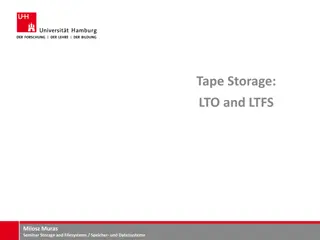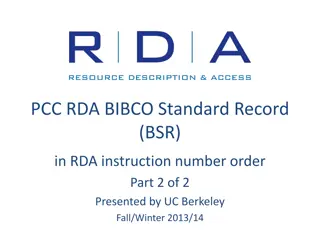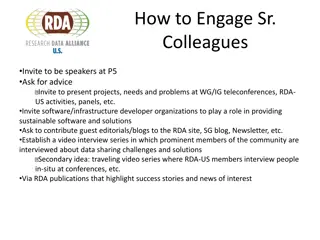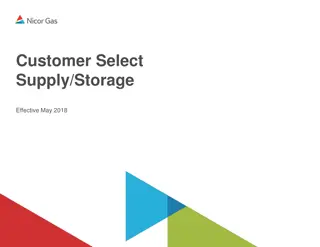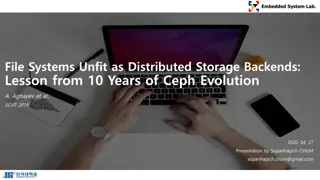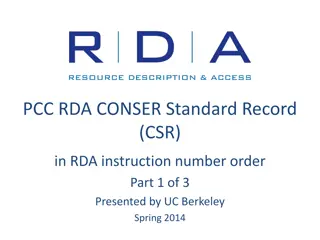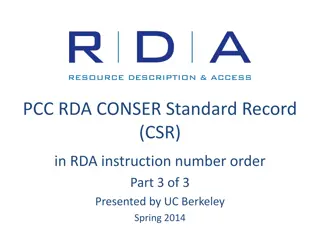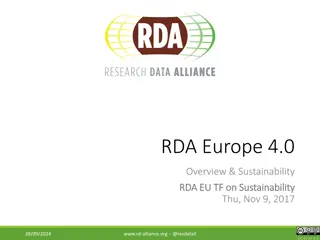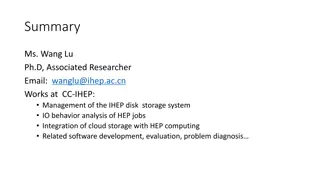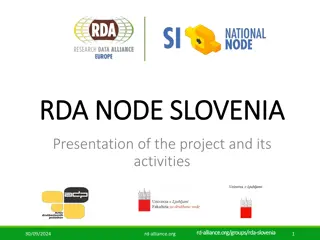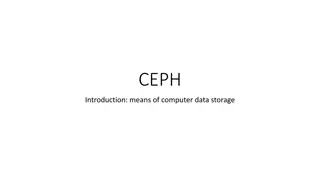RDA Data Capture and Storage Overview
RDA data elements, guidelines, and instructions for creating well-formed library and cultural heritage metadata are explored. Techniques for recording relationships between entities and applying new RDA entities are discussed.
Download Presentation

Please find below an Image/Link to download the presentation.
The content on the website is provided AS IS for your information and personal use only. It may not be sold, licensed, or shared on other websites without obtaining consent from the author.If you encounter any issues during the download, it is possible that the publisher has removed the file from their server.
You are allowed to download the files provided on this website for personal or commercial use, subject to the condition that they are used lawfully. All files are the property of their respective owners.
The content on the website is provided AS IS for your information and personal use only. It may not be sold, licensed, or shared on other websites without obtaining consent from the author.
E N D
Presentation Transcript
RDA data capture and storage Gordon Dunsire Chair, RDA Steering Committee Presented to Committee on Cataloging: Description and Access II (CC:DA) - ALCTS CaMMS ALA Midwinter 2016, 11 January 2016, Boston, Mass.
Overview RDA for data management: a continuous process of development From here to the future, and what is on the way
RDA data RDA is a package of data elements, guidelines, and instructions for creating library and cultural heritage resource metadata that are well-formed according to international models for user-focussed linked data applications. RDA Toolkit provides the user-focussed elements, guidelines, and instructions. RDA Registry provides the infrastructure for well-formed, linked, RDA data applications.
Recording relationships in RDA RDA offers a choice of techniques for recording relationships between entities. The number of options varies depending on the type of entity: 4 techniques for relationships between works, expressions, manifestations, and items 3 techniques for primary relationships between works, expressions, manifestations, and items 2 techniques for relationships between persons, families, and corporate bodies.
a: Identifier b: AAP c: Description The 4-fold path c1: Structured c2: Unstructured b:Excludes manifestation and item
a: Identifier b: AAP c: Description The 3-fold path c1: Structured semi-structured?
The 2-fold path a: Identifier b: AAP
New FRBR-LRM entities Collective agent Place Nomen Timespan F C Encompasses: Identifier AAP VAP Structured description Transcribed title, etc. What techniques will apply to new RDA entities? a: Identifier b: AAP c1: Structured? c2: Unstructured?
Structured description A full or partial description of the related resource using the same data that would be recorded in RDA elements for a description of that related resource presented in an order specified by a recognized display standard. [Example: ISBD display pattern] Title proper : other title information / statement of responsibility How full? A complete ISBD record with all of the data? RDA : an introduction / by J. Smith Title proper: RDA Other title information: an introduction Statement of responsibility: by J. Smith
Database implementation scenarios 0: Linked data Fully linked (global) 1: Relational or object database Fully linked (local) 2: Bibliographic and authority records AAP/Identifier linked 3: Flat-file Not linked
Techniques for obtaining data Categorization of elements? Recorded elements Sources any (authoritative, recognized, etc.) Tasks all (Find, Identify, Select, Obtain, Explore) Entities all is form of? Transcribed elements Sources Manifestation (Item in hand) Tasks Identify Entities Manifestation
Transcription What you see is what you get? Digital image Optical Character Recognition transcription EDINBURGH: Printed for the Author, And fold at his Mufic-fhop at the Harp and Hautboy, M D C C L X I J.
Transcription What you see is what you get? User transcription EDINBURGH: PRINTED FOR THE AUTHOR, And fold at his Music-fhop at the Harp and Hautboy. MDCCLXII.
Transcription What you see is what you get? Edinburgh: Printed for the author, and sold at his music-shop at the Harp and Hautboy, 1762
Transcription for Identify task Digital image is: Quickest and cheapest Easiest for user with item/image in hand App + Camera + Touch-screen + Image matching software service 21st century! Web of machines! Transcription string for item citation: User must know transcription rules Is OCR good enough? Feedback capture = Crowdsourcing
Recording for user tasks If data is not transcribed, it is recorded Recording excludes (more or less): Typos Deliberate errors Fictitious entities Some of the recorded data support the Find, Identify, Select, Obtain, or Explore user tasks How can the data best be accommodated in RDA?
N-fold path 1. Unstructured string. 1. Exact transcription (OCR or born digital). 2. Transcription using the RDA guidelines. 3. Data recorded from another source. 2. Structured string of delimited sub-values. 1. Access point. 2. Structured description. 3. Structured string. 1. Identifier 4. URI of entity, including Nomen. 1. URI/URL of digital image.
The path starts here Paths are available for describing related entities The same paths describe the entity in focus Xox oxox oxo xoxo x oxo Xox oxox: oxo xoxo. / xoxo. - x oxo xo xoxo. - Xo xox oxox; oxo xo oxo. ID: xox-oxox URI
Developing Toolkit guidance and instructions Methods of recording RDA data General guidance on techniques (4-fold path) General instruction sets for specific entities and element categories (attribute, relationship) Specific instructions for specific elements
Developing RDA Registry for applications Elements for storage of RDA (linked) data Element domain = parent Entity (constrained) Element range = type of path (not currently specified) Sub-properties (sub-types) of each element have 2 types of range to accommodate 4-fold path: literal and object Element range Path Literal Unstructured Literal (associated with construction encoding scheme) Structured/AP/Identifier Object URI
New high-level relationship elements New entities Res Place Agent Timespan W E Collective agent Nomen M I C P F New relationship designators (cross-entity)
Toolkit Entity views Proposed development to provide a focus for each RDA entity and its elements Replaces out-of-date Element set views Acts as a ready-reference to all elements and instructions associated with the entity
Entity view: a dictionary/reference for RDA Possible layout Entity definition, etc. Guidance and instructions Entity elements Common elements Specific elements With n-fold path: literal range + associated structure object (Entity) range
Re-organizing the Toolkit Appendices and tabs Vocabulary Encoding Schemes Sharing, extending, linking (RDA and other communities) RDA Reference (entities, elements, terms) Glossary How far beyond entities, elements, and vocabulary terms? Translations Policy statements and application profiles Entity views, Relationship designators, etc.
Some issues Needs of international, cultural heritage, and linked data communities Primary (WEMI) vs Secondary (PFC ) entities Reciprocal relationships/links/designators Elements other than those for access points? Structure in descriptions How much specification? International communities use different structures Nomen control (a kind of authority control?) Relationship designators Cross-entity, and many more (labels, definitions?)
Thank you! rscchair@rdatoolkit.org http://access.rdatoolkit.org/ http://www.rdaregistry.info/ http://www.rda-rsc.org/
